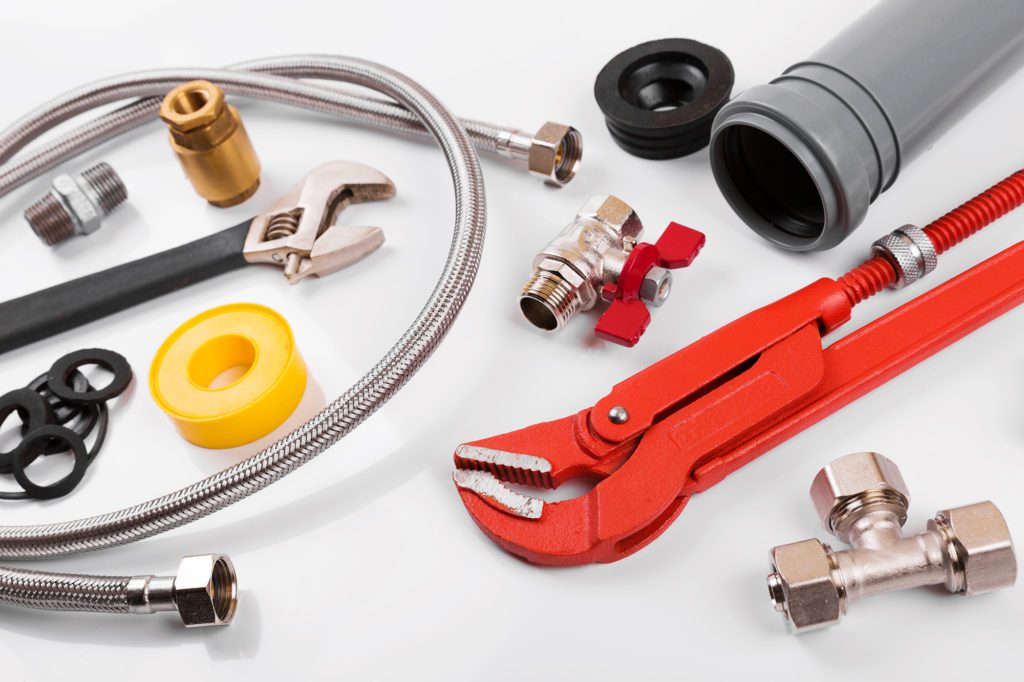Professional plumbers are highly skilled individuals, and they use specific tools to overcome any plumbing problems you may have. They often carry these tools in their tool bag or box and rely on them regularly to finish plumbing jobs. Let’s discuss 11 common plumbing tools to give you an idea of the contents in a plumber’s tool bag.
Before we begin, always remember to contact Top of the Line Plumbing in Jacksonville, Florida, for the best plumbing solutions from the most experienced professional plumbers.
11 Common Plumbing Tools
We have categorized the following common plumbing tools to help you better understand each one’s specific use.
Wrenches
A wrench is the most common and important plumbing tool of all. It has many uses in plumbing, like for holding, turning, or fixing plumbing pipes and fixtures. There are many different types of wrenches, and here are the ones plumbers commonly use.
1. Pipe Wrench
As the name implies, a pipe wrench is a heavy tool used to loosen or tighten fittings on a pipe. This wrench is also the largest one in a plumber’s toolbox. Typically, a plumber would use two pipe wrenches together to rotate the fitting or nut and the other to hold the pipe from rotating.
Naturally, the direction of the rotation will result in either tightening or loosening of the target fixture or nut. There are different lengths of pipe wrenches, and a good plumber will carry the whole set to overcome any situation.
2. Adjustable Wrench
Adjustable wrenches are designed to loosen and tighten fittings and nuts with a hexagon shape. There are many different adjustable wrenches, but plumbers typically use 6-inch and 10-inch variants for most plumbing jobs
because the other sizes are not standard for use in plumbing.
3. Basin Wrench
These are T-shaped wrenches mainly used on faucets, considered one of the best tools for plumbers since it allows them to reach tight spaces and secure the nuts keeping your faucets running smoothly. It has a clamp design at the end that makes it functional and easy to use for plumbers working on faucets.
Pipe Work
The majority of a plumber’s work involves pipes, and they use a variety of tools to install, replace, and repair pipes around your home. Some of these tools allow them to work in tight spaces, which is a common element of working on plumbing pipes.
4. Pliers
Similar to wrenches, pliers are a very frequently used tool for plumbers. Their small size enables plumbers to tighten or loosen the nuts that too little for a typical wrench. Another advantage of their smaller size is that they can often reach tight spaces where a wrench may be difficult to use.
5. Hacksaw
You may not have thought that plumbers use hacksaws, but they have plenty of hardware to cut through, including bolts, nuts, and pipes. Plumbers often carry a hacksaw and keep extra blades around in case they need them.
However, cutting with hacksaws is dangerous, and professional plumbers will take all the necessary safety precautions for using one.
6. Pipe Cutters
Pipework involves cutting and resizing pipes for installations and repairs. The pipes range from copper to plastic and many variants in between. Whether metal or plastic, there are plenty of handheld pipe cutters available that work with plumbing pipes.
Their compact design is similar to pliers, but they have a cutter at the open end to cut through pipes.
A good plumber will always have reliable ones that get the job done. Pipe cutters are also good as a replacement for hacksaws because they are far less dangerous than open-blade hacksaws.
7. Plumber’s Torch
Copper pipes need to be soldered when you have to seal them. A plumber will always carry a plumber’s torch for such repairs – a compact, handheld tool that creates immense heat in a targeted area to solder and seal pipes.
Clog Work
Clogs are a common problem that plumbers have to solve regularly. Here are the common tools they use for clogs and blockages.
8. Plunger
Here is a tool that is most associated with plumbers. While you may have a typical plunger in your home, plumbers often use heavy-duty flange and cup plungers that produce far more suction than your average home plunger.
They make it easier for plumbers to get rid of clogs and blockages in your toilet.
9. Hand Auger
There are many modern variants of this tool, but a hand auger is a circular handheld plumbing tool used to run a cable deep inside a blocked drain. It is then used to break open blockages and clear any clogs.
Motorized hand augers, known as snake machines, are more powerful and make the job easier.
Safety Precautions
Safety is a big part of plumbing, and a professional plumber will always take safety precautions while working on a plumbing job. They typically use the following safety items for protection.
10. Heavy-Duty Gloves
Plumbers often work on sewage pipes and other things that involve getting your hands dirty. They use special heavy-duty gloves that prevent them from touching harmful things while providing ample grip for their plumbing tasks.
11. Safety Goggles
Plumbing requires closely inspecting and working on potentially dangerous aspects of pipes and fixtures. A good plumber always has their safety goggles on for any plumbing job.
Conclusion
You may be wondering why we didn’t mention common tools like screwdrivers. We omitted those tools because they are not plumber-specific tools. The tools mentioned in this are the ones they most specifically use for plumbing jobs.
A good professional plumber will always have the mentioned tools available to them to tackle any plumbing job you throw at them. If you live in or around Jacksonville, Florida, Top of the Line Plumbing is your best option for the most experienced professional plumbers.
They are experts and have all the right tools to tackle any plumbing job.
If you want to learn more about common plumbing tools or want the best plumbing solutions in Jacksonville, Florida, Contact Us today.





